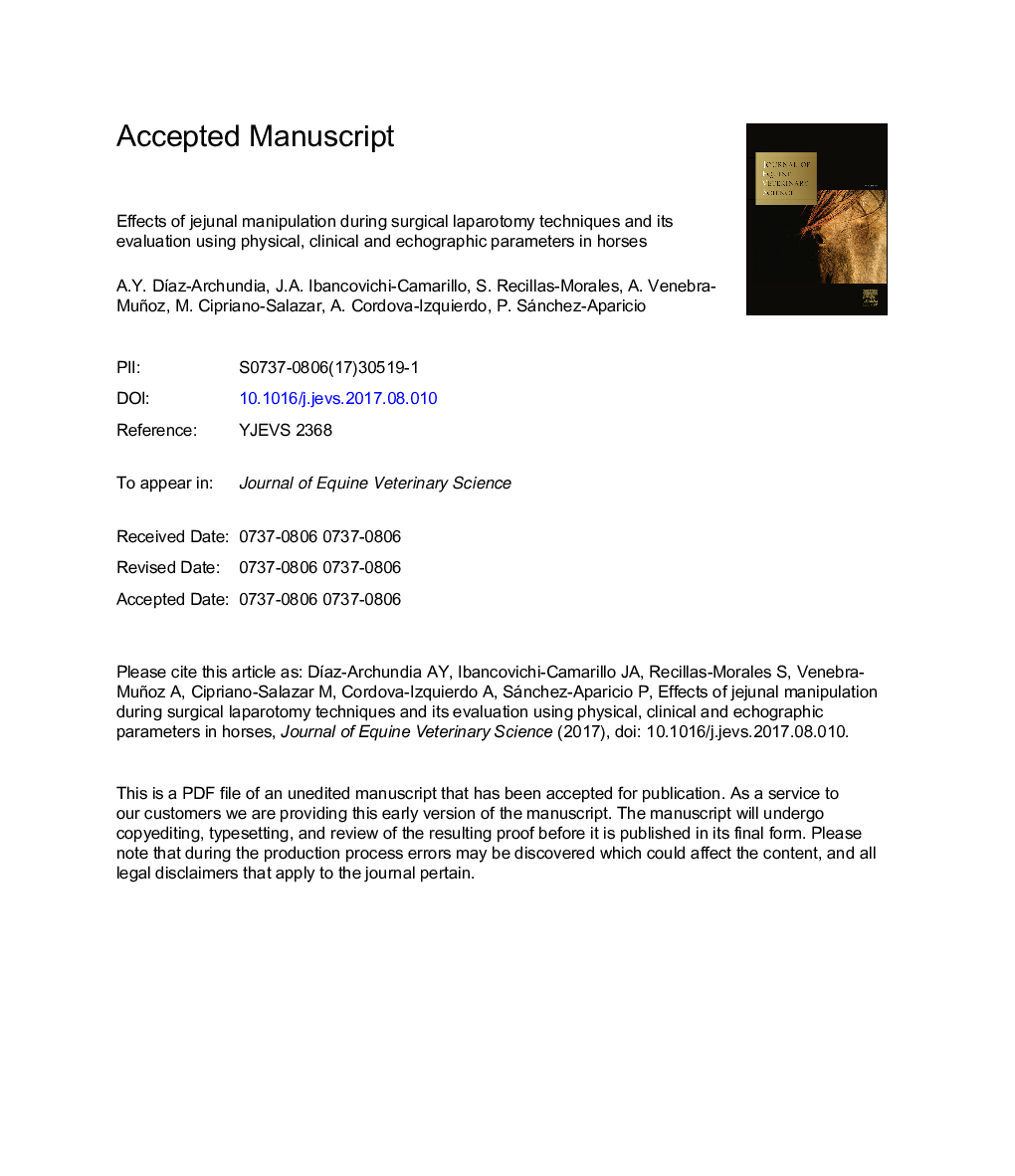| کد مقاله | کد نشریه | سال انتشار | مقاله انگلیسی | نسخه تمام متن |
|---|---|---|---|---|
| 5535388 | 1551542 | 2017 | 24 صفحه PDF | دانلود رایگان |
عنوان انگلیسی مقاله ISI
Effects of Jejunal Manipulation During Surgical Laparotomy Techniques and Its Evaluation Using Physical, Clinical, and Echographic Parameters in Horses
ترجمه فارسی عنوان
اثرات دستکاری ژیونال در روشهای جراحی لاپاروتومی و ارزیابی آن با استفاده از پارامترهای جسمی، بالینی و اکوسیستم در اسب
دانلود مقاله + سفارش ترجمه
دانلود مقاله ISI انگلیسی
رایگان برای ایرانیان
کلمات کلیدی
موضوعات مرتبط
علوم زیستی و بیوفناوری
علوم کشاورزی و بیولوژیک
علوم دامی و جانورشناسی
چکیده انگلیسی
The laparotomy surgical procedure allows for the identification and correction of intestinal lesions associated with acute abdomen in horses. The clinician relies on various laparotomy techniques to diagnose and treat this syndrome, and to date, the postsurgical effects of these techniques have not been clarified. The aim of this study was to evaluate the effects of jejunal manipulation during three laparotomy techniques through physical and clinical parameters and echography. Fifteen healthy horses were randomly assigned to three groups: animals in G1 (n = 5) were subjected to an exploratory laparotomy, animals in G2 (n = 5) to a laparotomy with an enterotomy, and animals in G3 (n = 5) to a laparotomy with an enterectomy. Degree of pain, jejunal wall thickness, and clinical parameters were evaluated before and after surgery. Horses in G3 had higher heart rates, respiratory frequency, degree of pain, and jejunal wall thickness compared with G1. Clinical variables during the postsurgical period were compared among the laparotomy techniques, and higher values of erythrocytes, leucocytes, neutrophils, and proteins were found in horses belonging to G3 compared to those in G1. Intestinal manipulation during the surgical procedure altered the physical and clinical parameters, as well as the results of the echography evaluation, with more significant effects from laparotomy with enterectomy. In the postsurgical period, the heart rate of horses in G3 was higher (P = .02) than the values obtained in G1 and G2. Upon the evaluation of degree of pain, statistically significant differences (P = .04) were identified between horses in G1 versus G3. G3 animals presented a higher degree of pain. Regarding the erythrocytes (L/L), higher values were measured in G3 (PÂ = .001) in comparison with G1 and G2. These results suggest that meticulous tissue handling is essential to minimize intestinal trauma and inflammation.
ناشر
Database: Elsevier - ScienceDirect (ساینس دایرکت)
Journal: Journal of Equine Veterinary Science - Volume 58, November 2017, Pages 40-46
Journal: Journal of Equine Veterinary Science - Volume 58, November 2017, Pages 40-46
نویسندگان
Adriana Yolanda DÃaz-Archundia, José Antonio Ibancovichi-Camarillo, Sergio Recillas-Morales, Arturo Venebra-Muñoz, Moisés Cipriano-Salazar, Alejandro Cordova-Izquierdo, Pedro Sánchez-Aparicio,
